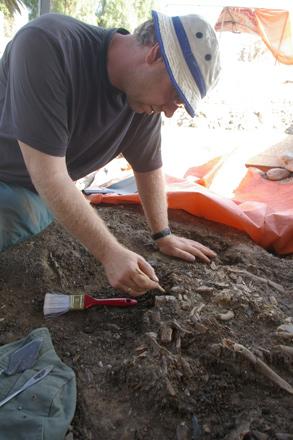You are here
Excavations put spotlight on ancient human settlements in Azraq
By Saeb Rawashdeh - Sep 02,2019 - Last updated at Sep 02,2019

Excavation at an ancient burial site at Ayn Qasiyyah, located some 100 kilometres east of Amman (Photo courtesy of Tobias Richter)
AMMAN — The Azraq region appears to have been a magnet for human settlement in the Epipalaeolithic period, which dates back 20,000 to 10,000 years.
The Azraq oasis and its hinterland, located 100 kilometres east of Amman, are phenomenally rich in sites. “We still do not fully understand why,” noted Tobias Richter, a professor from University of Copenhagen.
Excavations in Ayn Qasiyyah, a site in the Azraq Wetlands Reserve, exposed thick deposits, he continued, adding that the faunal remains can provide some detailed information about the past environment, hunting practices and at what point during the year people inhabited the site.
“Ayn Qasiyyah was probably a seasonally occupied locality. Various lines of evidence, such as the animal bones from the excavation, suggest that the site was probably occupied during the winter and spring seasons,” Richter said, adding that besides many bird bones the excavations exposed sediments that are associated with marshy conditions.
Furthermore, Azraq springs were active at that time and supplied the area with abundant fresh water.
The remains of what appears to have been an older adult (more than 30 years of age) were excavated in 2007 in Ayn Qasiyyah, one of the oldest human burials that has yet been found in Jordan, Richter highlighted.
“This person was buried in the soft marshy deposits of the oasis. It is one of only a handful of complete burials from this period,” the professor noted.
Regarding faunal remains, the team found gazelle as well as many migratory and bird species.
“We can see that people had access to a wide range of animals that lived in the oasis,” Richter said.
Ancient inhabitants of the area around Azraq hunted gazelle, birds and other animals, such as tortoise, wild donkey and hare, he continued, adding that they most probably also gathered edible plants from the surrounding environment.
“We have found, for example, the remains of almonds in the archaeobotanical assemblage. Other plants would have probably been wetland species, such as club rush, but these do not preserve so well, unfortunately,” the researcher said.
The excavation at the site was finished in 2007, but the work is far from over, he added.
“Various lines of analysis of the materials we have excavated still continue. We are still learning things about the site, especially when we compare our data with that of colleagues working in the same region,” Richter said.
Related Articles
AMMAN — Former marshes near Azraq and their "assemblages of stone tools" may offer some clues about the Paleolithic period in Jordan,
AMMAN — By the end of the last Ice Age, hunter-gatherers in southwest Asia who belonged to the Natufian culture (12,500 to 9,500BC), establi
AMMAN — The rehabilitation of the Azraq Wetland Reserve and the pumping of water to different parts of the oasis have diversified the bird s

















